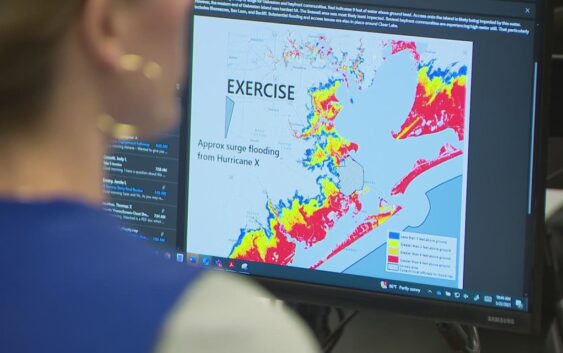- Why no hurricanes made landfall in the US in 2025
- Florence to begin interviewing police chief finalists in January
- A West Texas county wants to better prepare for floods. Paying for it will be tricky.
- They couldn’t save their daughters’ lives in the July 4 floods. Now they’re dealing with the grief and the guilt.
- Austin could see heavy rains, possible flooding over the next few days
CenterPoint prepares for upcoming hurricane season by simulating response

From pre-staging resources to installing more than 100 weather stations, CenterPoint said it’s doing everything it can to be prepared for hurricane season.
HOUSTON — Inside CenterPoint Energy’s emergency operations center, a simulated Category 3 hurricane unfolded Thursday as part of the company’s effort to improve its storm preparedness ahead of hurricane season.
The full-scale exercise involved more than 200 CenterPoint employees, and it was put on following what many viewed as CenterPoint’s inadequate response to Hurricane Beryl last July, when widespread outages left customers without power—and without answers.
“This is about creating muscle memory,” said Jason Wells, CenterPoint’s President and CEO, emphasizing the need for readiness across departments.
Wells acknowledged that the company has ground to cover in ensuring customers that things will be different this hurricane season.
“I know we have a lot of work to do to rebuild that trust,” he said. “We have done an incredible amount of work on our system over the course of the last year.”
During Beryl, one of the key issues was a lack of preparedness. Now, CenterPoint says it is proactively pre-staging resources and personnel in more than 30 areas across its service region.
“We’ve increased our capacity to bring in more than 25,000 additional workers to leverage the workforce that we have,” said Don Daigler, CenterPoint’s Senior Vice President of Emergency Preparedness and Response.
In addition to increasing workforce capabilities, the company says it has installed 26,470 storm-resistant utility poles and cleared 6,018 miles of vegetation near power lines—both aimed at minimizing future outages.
Many customers also said communication was another point of failure on CenterPoint’s part during last summer’s storm. CenterPoint officials said a new outage tracking system will keep customers better informed, even under heavy usage.
“With our new outage tracker, it is now Cloud-based and auto-scalable,” said Tony Gardner, CenterPoint’s Senior Vice President and Chief Customer Officer. “The amount of traffic that comes in—the system will not crash. It will still be available for our customers.”
Technology upgrades also include the deployment of “trip savers,” designed to reduce unnecessary outages caused by minor disturbances on the lines.
“Let’s say it’s a squirrel or a tree branch that causes a fault on the line,” explained Darin Carroll, CenterPoint’s Senior Vice President of Electric Business. “It will sense that it was just temporary, and it will automatically re-energize that line.”
CenterPoint is also building out its in-house storm forecasting capabilities, which is crucial right now as federal budget cuts affect the National Weather Service and NOAA.
“We have our own in-house team and we’re continuing to build it out,” said Keith Stephens, CenterPoint’s Chief Communications Officer. “We’re building our own network of weather stations. We’re starting with 100. More to come.”
The company said it plans to continue running similar hurricane simulations throughout the summer.